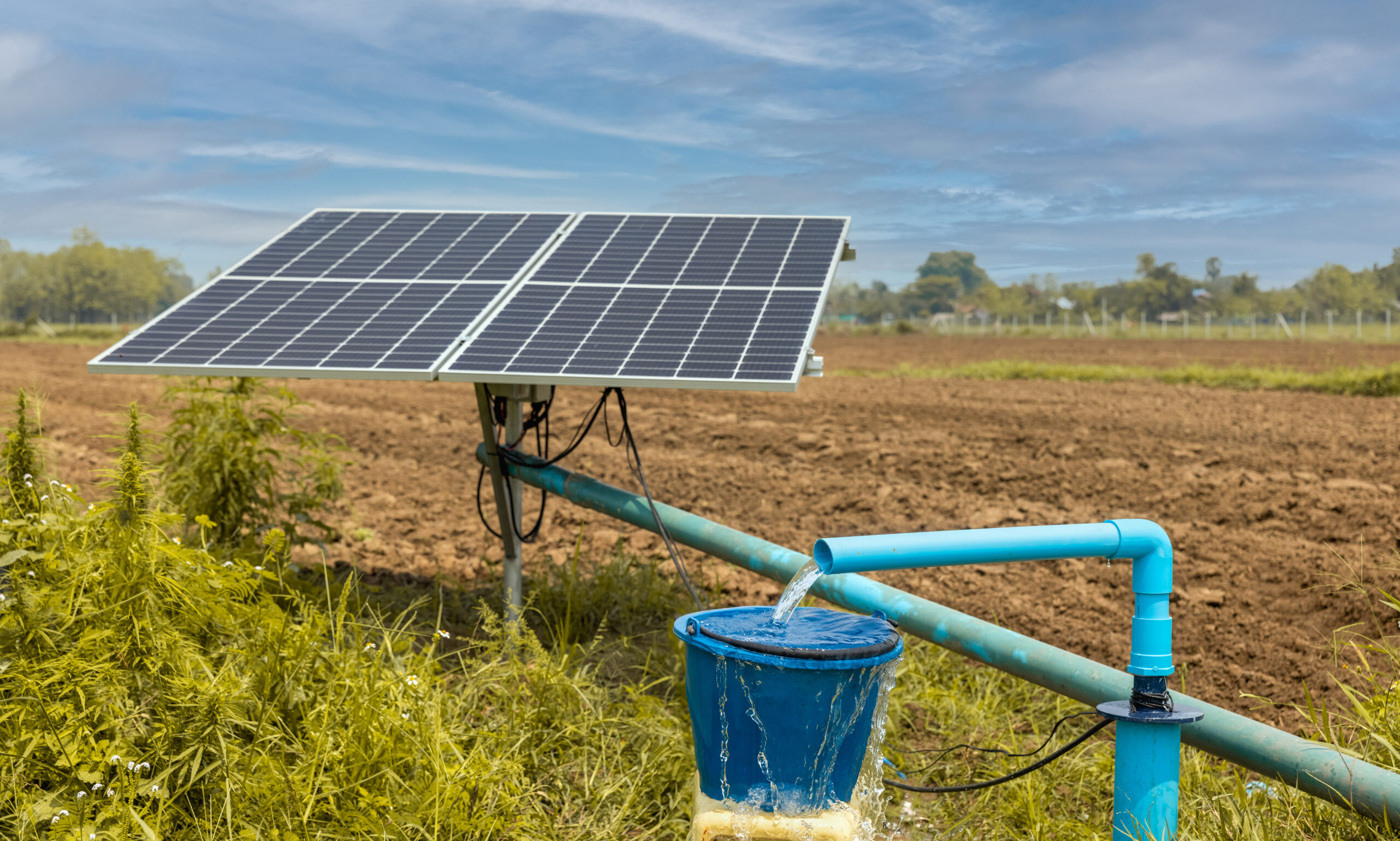
Solar Submersible Pump
A Solar Submersible Pump is a water pumping system powered by solar energy. It is commonly used in agriculture, irrigation, domestic water supply, livestock watering, and other applications where water needs to be lifted from deep underground sources like wells, boreholes, or rivers. Solar submersible pumps are highly efficient, environmentally friendly, and cost-effective in areas with plenty of sunlight and limited access to grid electricity.
1. Components of a Solar Submersible Pump System:
A solar submersible pump consists of several main components that work together to pump water using solar energy:
a. Solar Panels:
Function: Captures sunlight and converts it into electricity to power the pump.
Types:
Monocrystalline Solar Panels: More efficient, often used in solar pump systems that require higher energy output.
Polycrystalline Solar Panels: Less efficient but more affordable and commonly used.
Power Output: Solar panel capacity typically ranges from 100W to 3000W, depending on the size and depth of the pump system.
b. Submersible Pump:
Function: A pump submerged in water that lifts water from underground sources to the surface.
Types:
AC Pumps: Operates on alternating current (AC) and often requires an inverter to convert the DC power from the solar panels.
DC Pumps: Operates directly on direct current (DC) power generated by the solar panels, improving efficiency by eliminating the need for conversion.
Materials: Pumps are typically made from stainless steel to resist corrosion and wear in harsh underwater environments.
Power Capacity: Submersible pumps come in various power ratings, from 200W to over 5000W, depending on the depth and water output requirements.
c. Solar Pump Controller:
Function: Regulates the power flow between the solar panels and the pump, protecting the pump from damage and ensuring efficient operation.
Key Features:
Maximum Power Point Tracking (MPPT): Ensures that the solar panels operate at their maximum efficiency under varying sunlight conditions.
Protections: Includes overload, dry run, and low-voltage protections to prevent damage to the pump and ensure smooth operation.
d. Inverter (for AC Pumps):
Function: Converts the DC power generated by the solar panels into AC power to run the pump (only necessary for AC pumps).
Types:
Pure Sine Wave Inverter: Used for systems requiring clean, efficient power conversion.
Modified Sine Wave Inverter: More affordable, but less efficient compared to pure sine wave inverters.
e. Water Storage Tank (Optional):
Function: Stores the pumped water for later use, particularly useful in areas with irregular sunlight or low water availability.
f. Sensors and Switches:
Water Level Sensors: Installed in wells or tanks to monitor water levels and prevent the pump from running dry.
Float Switches: Can automatically stop the pump when a water storage tank is full to prevent overflow.
2. Types of Solar Submersible Pumps:
a. DC Solar Submersible Pumps:
Description: Powered directly by DC electricity generated by the solar panels.
Advantages: Highly efficient, eliminates the need for an inverter, and reduces power losses.
Applications: Ideal for off-grid installations, where maximum efficiency is required.
b. AC Solar Submersible Pumps:
Description: Powered by AC electricity, which is converted from the DC solar power using an inverter.
Advantages: Suitable for larger pumps and systems where higher power output is required.
Applications: Can be used in areas with access to both solar power and grid power as a backup.
c. Hybrid Solar Submersible Pumps:
Description: Can operate on both solar power and grid power or diesel generators. It automatically switches between power sources depending on availability.
Advantages: Ensures continuous operation even during cloudy days or at night when solar power is insufficient.
Applications: Ideal for remote locations with limited grid access but occasional need for continuous pumping.
3. Working Principle:
Solar Panel Function: During daylight hours, the solar panels capture sunlight and convert it into electrical energy.
Pump Operation: The electricity powers the submersible pump, which lifts water from underground to the surface. The pump’s motor is either powered directly by the solar panels (in DC systems) or through an inverter (in AC systems).
Water Storage: Water is either delivered directly to the point of use (irrigation, drinking, etc.) or stored in a tank for later use.
Controller’s Role: The pump controller optimizes the power delivery and ensures the system operates efficiently and safely.
4. Advantages of Solar Submersible Pumps:
Environmentally Friendly: Solar-powered pumps use renewable energy, reducing carbon emissions and the environmental impact of water pumping.
Cost-Effective: Although the initial investment may be high, solar pumps have low operational costs as they do not rely on grid electricity or fuel.
Off-Grid Operation: Solar pumps are ideal for remote areas without access to electricity, allowing for water access in off-grid locations.
Low Maintenance: Solar submersible pumps have fewer moving parts and lower maintenance requirements compared to diesel-powered pumps.
Durable and Long-Lasting: High-quality solar pumps can last over a decade with minimal maintenance, especially with corrosion-resistant materials.
Water Source Management: The system can be configured to pump water during peak sunlight hours, ensuring an efficient and consistent water supply.
5. Applications of Solar Submersible Pumps:
Agriculture and Irrigation: Solar submersible pumps are widely used in agricultural fields for irrigation, especially in areas with abundant sunlight and limited electricity.
Drinking Water Supply: Solar pumps provide a reliable solution for extracting water for drinking and household use in rural or remote communities.
Livestock Watering: Solar pumps can be used to fill water tanks for livestock, ensuring a constant water supply for animals in remote grazing areas.
Aquaculture and Fisheries: Solar-powered pumps are often used in fish farms to maintain water levels and ensure proper water circulation.
Community Water Projects: In many developing regions, solar submersible pumps are part of community water systems, providing sustainable access to clean water.
6. Key Specifications to Consider:
Pump Capacity (Flow Rate): Measured in liters per minute (LPM) or cubic meters per hour (m³/h), this determines how much water the pump can lift in a given time.
Head (Lift Height): The vertical distance the pump can lift water, measured in meters (m). This is critical for deep wells or boreholes.
Power Requirements: Determined by the depth of the well, the water output required, and the efficiency of the solar panels.
Solar Panel Size: The size and capacity of the solar panels should match the pump’s power requirements for optimal performance.
Battery Backup (Optional): In some systems, batteries are included to store solar energy for use at night or during low sunlight conditions.
Inverter Size (For AC Systems): The inverter size must match the pump’s power requirements, especially in hybrid systems.
7. Maintenance of Solar Submersible Pumps:
Cleaning Solar Panels: Regularly cleaning the solar panels to remove dust and debris will ensure optimal power generation.
Checking Electrical Connections: Inspect wiring and connections periodically to prevent power loss or system failures.
Pump Inspection: While solar pumps are designed to last, periodic inspection for wear and tear, especially in high-use environments, is recommended.
Controller Maintenance: Ensure that the controller settings are optimized and that any protective features (e.g., dry-run protection) are functioning properly.
8. Cost Considerations:
Initial Investment: Includes the cost of the pump, solar panels, controller, wiring, and installation.
Long-Term Savings: Once installed, solar submersible pumps have low operational costs as they do not require fuel or grid electricity.
Government Subsidies: In some regions, government programs and subsidies are available to encourage the use of solar-powered water pumps, reducing the initial investment.
Conclusion:
Solar submersible pumps offer an eco-friendly and cost-effective solution for water pumping in areas with abundant sunlight. With the right setup, they can be highly reliable, especially in remote and off-grid locations. Although the initial cost may be higher
